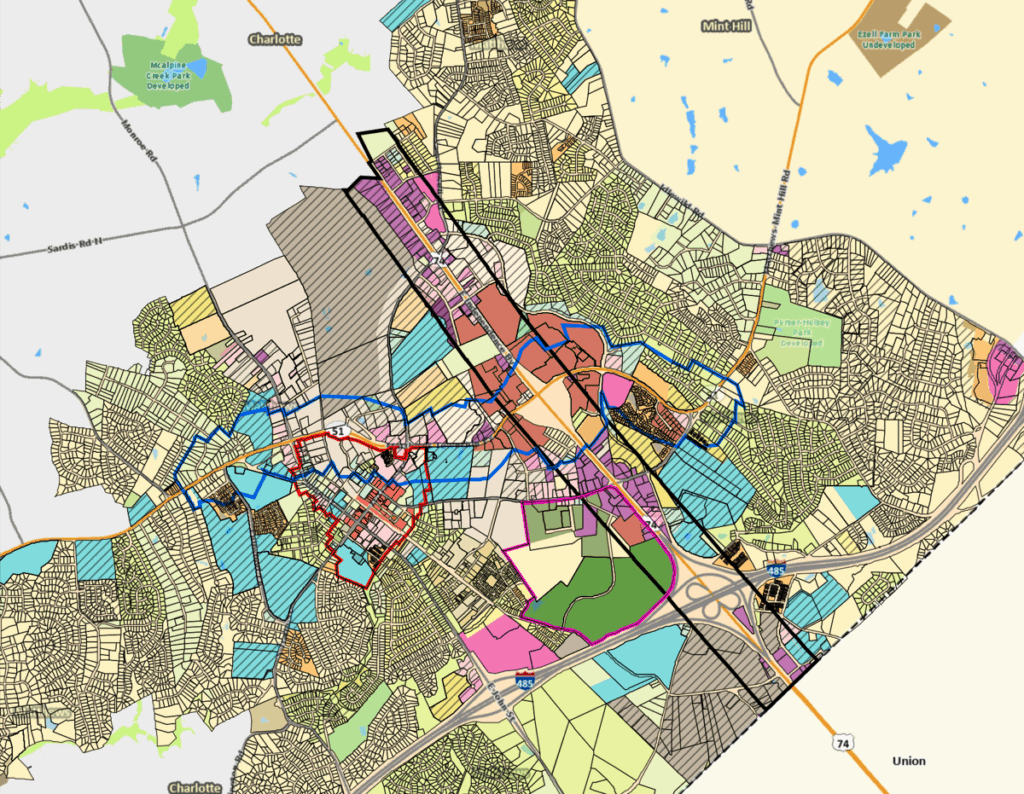The tremendous growth of commercial and residential development over the last 10 years in the Town of Matthews has led many to express dismay about any proposed high-density projects, but a closer look at the town’s long-term planning goals provides a much clearer picture of what the town envisions for the future and how state laws may inhibit those goals.
The town in 2024 adopted a new comprehensive plan, an outline of future planning goals based on the interests of residents and elected officials, a massive project that outlines what the town and its residents want. In developing the plan, the town held numerous public information sessions and public hearings, and published each phase of its progress, culminating in the plan adopted in May 2024. The plan is a guide to future planning, but it is not codified, meaning it’s a guide, not a legally binding blueprint for development.
The plan identifies areas where higher density development would be beneficial to balance the growing need for affordable housing with Matthews’ small-town charm. It defines these areas as a mix of types to ensure walkability, greenspaces and a focus on creating destinations. These areas are served by major traffic infrastructure, and such developments are intended to provide both residential and commercial uses that highlight residents’ demands that areas of the town are not overwhelmed with one type of housing or commercial use. Instead, the comprehensive plan encourages a variety — including apartments, townhouses, duplexes and single-family homes — that allow residents to grow or shrink their housing needs as they age, or transition from jobs to retirement. This mix aims to allow residents to continue to live in, and afford, Matthews.
The comprehensive plan and the town’s current zoning map show that Matthews has very few existing zones for high-density development. In fact, most of the town is already built out, so there’s little greenfield on which to build tracks of duplexes, apartments and town homes, or commercial centers.
However, the town does have some undeveloped areas zoned for industrial uses and single-family homes. There are also areas with existing structures that could be redeveloped. Some of the owners of these properties have petitioned the town to change the current zoning so they might build higher density apartments, townhouses, duplexes, retail centers and the recently withdrawn data center that was briefly proposed for a site near John Street and Route 485. Over the past few years, the town has approved some of these zoning changes, but many more were denied or withdrawn based on feedback from the Matthews Board of Commissioners, the Planning Board and the town’s Planning Department.
Still, the town must be very careful about rezoning because the state has ultimate authority. That’s because North Carolina does not have municipal home rule, which would give towns like Matthews the final say over anything the Board of Commissioners decides. Without it, the state has the power to make changes to local decisions and make new laws that limit local control. That includes local development. As a result, the town must be very explicit and justify its decisions to avoid being overruled by Raleigh.
For example, late in 2024 the General Assembly passed a new law that rewrote how all municipalities in North Carolina (except the exempt Mills River) can act on so-called down-zoning. Down-zoning is the process of reducing density on any particular parcel, barring towns like Matthews from reducing the density of a property from, say, duplexes to single-family homes without written consent from the property owner, an unlikely outcome.
The state law also limits permitted uses a town may set. That means Matthews cannot unilaterally reduce the density of any parcel as it’s currently zoned, giving property owners more rights to build out developments that adhere to current zoning and density regulations.
At the same time, towns like Matthews cannot eliminate current land uses without getting consent from all those currently operating under a particular approved use. For example, if the town wanted to ban all tattoo parlors (it doesn’t), it would need to get sign-offs from all tattoo parlor owners, a near impossibility. This locks in current uses. North Carolina municipalities can add uses, but they can’t remove or eliminate them under state law.
It’s not just North Carolina that’s wrestling with high-density zoning. In Alexandria, Va., a court recently ruled that the city’s decision to allow apartments and duplexes to be built on lots zoned for single-family homes was lawful. A citizen’s group organized against the city’s decision lost its fight to keep single-family lots dedicated to low-density development.
Many homeowners in Alexandria argued that the city’s decision would negatively impact water, sewer, traffic and other municipal infrastructure. By contrast, the city argued it would add less expensive housing options, increase diversity in some neighborhoods and address legacy redlining that kept minorities out of certain areas.
The Town of Matthews has no intent of following Alexandria’s example, but it’s clear that local municipalities across the country are working to balance growth and affordability — and the impact of that growth. The Town of Matthews takes a reasoned approach, preferring to listen closely to citizens’ concerns, address affordability and long-term residency, ensure any new architecture suits historic neighborhoods, and new property tax revenue from any development is worth the price of change.
